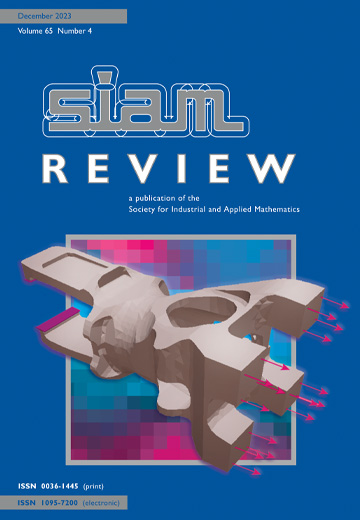调查和审查
IF 6.1
1区 数学
Q1 MATHEMATICS, APPLIED
引用次数: 0
摘要
SIAM Review》,第 66 卷,第 1 期,第 1-1 页,2024 年 2 月。 偏微分方程的数值方法只有在其数值解反映了相应偏微分方程物理解的基本特性时才能取得成功。对于对流扩散方程,某些特定标量的守恒性至关重要。当物理解满足代表物理边界的最大原则时,数值解也应遵守同样的边界。在数学环境中,这一要求被称为离散最大值原理(DMP)。不符合 DMP 的离散化容易导致数值解出现非物理值,例如虚假振荡。然而,当对流在很大程度上主导扩散时,许多离散化方法都不满足 DMP。Gabriel R. Barrenechea、Volker John 和 Petr Knobloch 在本期 "调查与评论 "部分的唯一一篇文章 "尊重对流-扩散方程离散最大原则的有限元方法 "中,研究并分析了成功符合 DMP 并同时提供精确数值解的有限元方法。这是一项非同小可的任务,因此,即使对于稳态问题,也只有少数几种这样的离散方法,而且都是非线性的。这些方法中的大多数都是最近才开发出来的,因此本文重点介绍了相关技术的发展状况,并突出强调了近年来所取得的巨大进步。本文的目的是对满足线性椭圆或抛物问题局部或全局 DMP 的有限元方法进行研究。它值得广大读者阅读。本文章由计算机程序翻译,如有差异,请以英文原文为准。
Survey and Review
SIAM Review, Volume 66, Issue 1, Page 1-1, February 2024.
Numerical methods for partial differential equations can only be successful if their numerical solutions reflect fundamental properties of the physical solution of the respective PDE. For convection-diffusion equations, the conservation of some specific scalar quantities is crucial. When physical solutions satisfy maximum principles representing physical bounds, then the numerical solutions should respect the same bounds. In a mathematical setting, this requirement is known as the discrete maximum principle (DMP). Discretizations which fail to fulfill the DMP are prone to numerical solutions with unphysical values, e.g., spurious oscillations. However, when convection largely dominates diffusion, many discretization methods do not satisfy a DMP. In the only article of the Survey and Review section of this issue, “Finite Element Methods Respecting the Discrete Maximum Principle for Convection-Diffusion Equations,” Gabriel R. Barrenechea, Volker John, and Petr Knobloch study and analyze finite element methods that succeed in complying with DMP while providing accurate numerical solutions at the same time. This is a nontrivial task and, thus, even for the steady-state problem there are only a few such discretizations, all of them nonlinear. Most of these methods have been developed quite recently, so that the presentation highlights the state of the art and spotlights the huge progress accomplished in recent years. The goal of the paper consists in providing a survey on finite element methods that satisfy local or global DMPs for linear elliptic or parabolic problems. It is worth reading for a large audience.
Numerical methods for partial differential equations can only be successful if their numerical solutions reflect fundamental properties of the physical solution of the respective PDE. For convection-diffusion equations, the conservation of some specific scalar quantities is crucial. When physical solutions satisfy maximum principles representing physical bounds, then the numerical solutions should respect the same bounds. In a mathematical setting, this requirement is known as the discrete maximum principle (DMP). Discretizations which fail to fulfill the DMP are prone to numerical solutions with unphysical values, e.g., spurious oscillations. However, when convection largely dominates diffusion, many discretization methods do not satisfy a DMP. In the only article of the Survey and Review section of this issue, “Finite Element Methods Respecting the Discrete Maximum Principle for Convection-Diffusion Equations,” Gabriel R. Barrenechea, Volker John, and Petr Knobloch study and analyze finite element methods that succeed in complying with DMP while providing accurate numerical solutions at the same time. This is a nontrivial task and, thus, even for the steady-state problem there are only a few such discretizations, all of them nonlinear. Most of these methods have been developed quite recently, so that the presentation highlights the state of the art and spotlights the huge progress accomplished in recent years. The goal of the paper consists in providing a survey on finite element methods that satisfy local or global DMPs for linear elliptic or parabolic problems. It is worth reading for a large audience.
求助全文
通过发布文献求助,成功后即可免费获取论文全文。
去求助
来源期刊

SIAM Review
数学-应用数学
CiteScore
16.90
自引率
0.00%
发文量
50
期刊介绍:
Survey and Review feature papers that provide an integrative and current viewpoint on important topics in applied or computational mathematics and scientific computing. These papers aim to offer a comprehensive perspective on the subject matter.
Research Spotlights publish concise research papers in applied and computational mathematics that are of interest to a wide range of readers in SIAM Review. The papers in this section present innovative ideas that are clearly explained and motivated. They stand out from regular publications in specific SIAM journals due to their accessibility and potential for widespread and long-lasting influence.
 求助内容:
求助内容: 应助结果提醒方式:
应助结果提醒方式:


